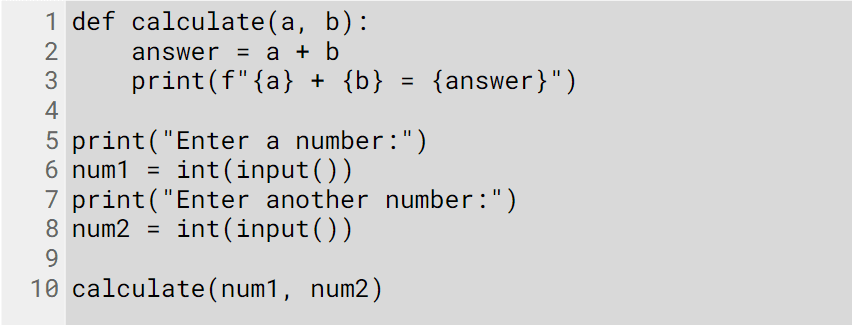Myths about teaching can hold you back
Learn why
These resources will be removed by end of Summer Term 2025.
Switch to our new teaching resources now - designed by teachers and leading subject experts, and tested in classrooms.
These resources were created for remote use during the pandemic and are not designed for classroom teaching.
Lesson details
Key learning points
- In this lesson, we will explore how to create our own functions. Functions are a type of subroutine that allow us to return a value. We have used them before when we have used code like print() and input(). We will also explore the difference between a function and procedure.
Licence
This content is made available by Oak National Academy Limited and its partners and licensed under Oak’s terms & conditions (Collection 1), except where otherwise stated.
3 Questions
Q1.In the image above, how many parameters does the subroutine "calculate" take?
In the image above, how many parameters does the subroutine "calculate" take?

1
3
4
Q2.In the image above, which one of the statements below best describes what is happening at line 10?
In the image above, which one of the statements below best describes what is happening at line 10?
It is adding a and b but will not output the answer until the subroutine has been called
It will prompt the user to enter two numbers
The subroutine calculate is being created/defined.
Q3.Using the image above, on line 1, are "a" and "b" described as arguments or parameters?
Using the image above, on line 1, are "a" and "b" described as arguments or parameters?
Arguments
3 Questions
Q1.What will be the return value based on the function call to_the_power(3,2)?
What will be the return value based on the function call to_the_power(3,2)?

12
3
6
Q2.What will be the return value based on the function call find_highest(12,9)?
What will be the return value based on the function call find_highest(12,9)?

3
9
No return value
Q3.What will be the return value based on the function call multiple(30,3)?
What will be the return value based on the function call multiple(30,3)?

No

